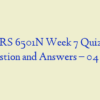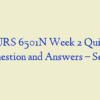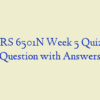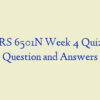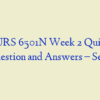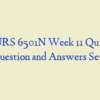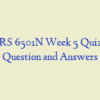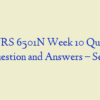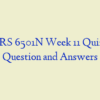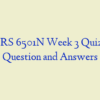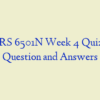Description
NURS 6501N Module 2 to 8 Knowledge Check
NURS-6501N-45-Advanced Pathophysiology-QTR-Term-wks-1- thru-11
Module 2 Knowledge Check
- Clinical manifestations of bronchiolitis include:
- How much oxygen does the myocardium extract from the coronary arteries?
- Inflammatory mediators released during an acute asthma episode cause:
- Parasympathetic nerves to the heart releases what the neurotransmitter?
- As a person ages, what type of changes occur in the myocardium and arterial walls?
- Norepinephrine action on a1-adrenergic receptors causes .
- Sympathetic nerves to the heart releases what the neurotransmitter?
- Inflammation of the membranous sac that surrounds the heart is a description of which condition?
- Acute rheumatic fever is a complication of a:
- A person who has pulmonary edema will exhibit which symptoms?
- A patient that is hyperventilating will have a decreased:
- Binding of ATP to myosin that enables myocardial contraction requires which electrolyte?
- The right side of the heart is a high-pressure system
- Passage of fluid and/or solid particles into the lungs is a(n):
- The V/Q ratio of a normal upright lunch is 0.8, this indicates that ventilation is than perfusion.
- Stimulation of the carina often causes:
- The most effective way to measure the adequacy of alveolar ventilation is to measure:
- Collapse of alveoli is a(n):
- Ischemic pain in the lower extremities that occurs while walking but disappears when resting is a description of which condition?
- The presence of pus in the pleural cavity is a(n):
NURS-6501N-45-Advanced Pathophysiology-2021-Summer- QTR-Term-wks-1-thru-11
Module 3 Knowledge Check
- Cells that remove bacteria and foreign particles from blood in the hepatic sinusoids are called?
- What hormone delay gastric emptying?
- Bilateral renal calculi can cause what type of acute kidney injury?
- A man with a cauda equina involvement in multiple sclerosis became incontinent when his caregiver was late and was not available to assist with the morning catheterization is experiencing what type of incontinence?
- Severe right-sided heart failure can cause:
- A patient with massive proteinuria, hypoproteinemia, hyperlipidemia, and edema is experiencing classic symptoms of:
- A patient with sudden onset of oliguria with elevated plasma BUN and plasma creatinine levels is experiencing classic symptoms of:
- A gastric enzyme that digests proteins is called
- Hypoxia causes the kidney to secrete what hormone?
- Filtration occurs in what portion of the kidney?
- Cells that secrete hydrochloric acid and intrinsic factor are called?
- The functional glomeruli are located in what part of the kidney?
- The decreased renal excretion of sodium and water is caused by what substance?
- A pancreatic enzyme that digests carbohydrates is called
- Bile acid are recycled by the body and absorbed via:
- A patient with severe colicky flank pain radiating to the groin, nausea and vomiting, and some hematuria is experiencing classic symptoms of:
- Acute mesenteric ischemia damages the intestinal mucosa and can eventually cause:
- The increased renal excretion of sodium and water is caused by what substance?
- What hormone stimulate gastric emptying?
- A salivary enzyme that digests carbohydrates is called
NURS-6501N-45-Advanced Pathophysiology-2021-Summer- QTR-Term-wks-1-thru-11
Module 4 Knowledge Check
- In autoimmune-mediated diabetes pancreatic beta cells are destroyed by autoreactive
- cytotoxic T lymphocytes B lymphocytes monocytes
- Cushing disease, primary hyperthryoidism and secondary hypothyroidism
- In order for a hormone to act on a cell, the cell must have for that hormone
- Nonpitting boggy edema caused by infiltration of mucopolysaccharides and proteins between connective tissue in the dermis describes what condition?
- What is the difference between brown and white adipocytes?
- Calcitonin regulates the plasma concentration of what electrolyte?
- Cytokines and hormones secreted by adipose tissue are known as
- Low blood sugar during the night that may lead to morning-rebound hyperglycemia describes what effect?
- What effect does high levels of leptin have?
- Hypertension, hypokalemia, increased blood pH, increased urine potassium are symptoms of what condition?
- Type of adipose tissue, located viscerally and subcutaneously, with adipocytes that have one lipid droplet are called as:
- A chemical signal generated within a cell that mediates the action of a water- soluble hormone or other chemical is known as:
- Extracellular fluid volume and plasma potassium concentration is regulated by what hormone?
- What effect does incretins have on postpostprandial blood glucose concentrations?
- HIgh levels of what hormone is common in syndrome of inappropriate antidiuretic hormone secretion (SIADH)?
- Weakness, fatigue, hypotension, hyperkalemia, hypoglycemia, elevated ACTH are symptoms of what condition?
- Lethargy, hyponatremia, perhaps seizure, decreased plasma osmolality, concentrated urine are symptoms of what condition?
- Type of adipose tissue located in bone marrow is called:
NURS-6501N-45-Advanced Pathophysiology-2021-Summer- QTR-Term-wks-1-thru-11-(05/31/2021-08/15/2021)-PT27
Module 5 Knowledge Check
- Characteristics of rheumatoid arthritis include:
- Clinical symptoms of rhabdomyolysis include:
- Characteristics of osteoarthritis include:
- Inflammation of the eyelid is best described as:
- Brain system that includes the amygdala, hippocampus, and thalamus is called:
- Involuntary slow, twisting, writhing movement is called:
- Muscle protein that stores oxygen is called:
- Neurons with cell bodies in the substantia nigra use as a neurotransmitter.
- Lipogranuloma of oil-secreting gland of the eyelid best describes a:
- Demyelination of the axon in peripheral nerves is the cause of:
- Damage to the cerebellum will cause what symptoms?
- During what stage of sleep does nocturnal angina occur?
- Which of the following conditions are have a fungal cause?
- Substance that gives synovial fluid its viscous quality is called:
- A neuron extension that carries impulses away from cell body is called:
- Damage to an upper motor neuron will cause muscle
- Which substances stimulates bone re absorption?
- Impaired recognition of tactile, visual, or auditory stimuli is called:
- Normal age related changes of the skin include:
- Stimulation of the sympathetic nervous system would cause:
NURS-6501N-45-Advanced Pathophysiology-2021-Summer-QTR-Term-wks-1-thru-11
Module 6 Knowledge Check
- The APRN is treating a patient with bipolar II disorder. The major focus of treatment is on:
- What type of thoughts are characteristic of post traumatic stress disorder?
- Obsessive compulsive disorder is characterized by what types of thoughts and behaviors?
- Which of the following are positive clinical manifestations of schizophrenia?
- A patient with schizophrenia will have alterations in
- Abnormalities in brain development related to schizophrenia are thought to develop when?
- The APRN would expect to find elevated blood levels of which of the following markers for patients with a diagnosis of depression?
- The APRN is assessing a patient that has monotone speech and unchanged facial expressions even though he states he is happy and excited about his life. This is an example of:
- The APRN is assessing a patient that states that Napoleon Bonaparte is the King of France even thought he has a book that says he is dead. This is an example of:
- The APRN is assessing a patient that is talking to his mother in the corner of the room even although you are the only other person in the room. This is an example of:
- Monoamine neurotransmission is hypothesized to be during mania.
- Which of the following are negative clinical manifestations of schizophrenia?
- Monoamine neurotransmission is hypothesized to be during depression.
- The neurobiology of depression is believed to be related to the atrophy of neurons in the:
- The APRN is assessing a patient that is talking so rapidly and urgently that it is difficult to understand. This is an example of:
- The APRN is treating a patient with bipolar 1 disorder. The major focus of treatment is
NURS-6501N-45-Advanced Pathophysiology-2021-Summer- QTR-Term-wks-1-thru-11
Module 7 Knowledge Check
- In the bone marrow, hematopoietic stem cells in the osteoblastic niche are active.
- All types of leukemia are characterized by uncontrolled production of white blood cells in the bone marrow that thereby decreases the amount and function of erythrocytes and platelets.
- What type of organism is syphilis caused by?
- What type of organism is gonorrhea caused by?
- After iron is absorbed it is stored inside cells attached to .
- What type of organism is Chlamydia caused by?
- Testicular torsion requires immediate treatment to prevent .
- Hemolysis from a mismatched blood transfusion is an example of what type of hemolytic anemia?
- In females, LH stimulates theca cells in the primary follicle to produce .
- In males, LH stimulates Leydig cells to produce
- Central precocious puberty is driven by what hormone?
- Which of the following chemicals inhibit platelet adhesion an aggregation?
- How does bacteria reach the prostate to cause acute bacterial prostatitis?
- HPV serotypes 6 and 11 are associated with .
- In a patient with polycystic ovary syndrome, the APRN would expect which hormone changes?
- Benign prostatic hyperplasia (BPH) begins in the what area of the prostate?
- What clinical symptoms are caused by multiple myeloma because the malignant cells reside in the bone marrow and not in the circulating blood?
- The production of ova in the female occurs:
- What is the most common prostate cancer in men?
- Premenstrual syndrome and premenstrual dysphoric disorder occur during which phase of the menstrual cycle?
NURS-6501N-45-Advanced Pathophysiology-2021-Summer- QTR-Term-wks-1-thru-11
Module 8 Knowledge Check
- A child with MYCN oncogene is at risk for developing which type of cancer?
- Infants that have seizures typically have what types of symptoms due to the normal development of the nervous system?
- Cerebral palsy involves what type of defects?
- An adolescent that uses anabolic steroids to increase muscle mass is at risk for developing which type of cancer?
- Red, round, and scaling patches with a clear center that occur mostly on the face, trunk, and limbs in an asymmetrical distribution describes which of the following conditions?
- Sickle cell anemia is usually detected at birth because fetal hemoglobin is affected by the genetic mutation.
- Rotavirus is the leading cause of what symptom in infants and young children?
- A tetrology of flow will cause what type of blood shunting?
- Respiratory distress syndrome in the newborn is caused by the deficiency of what substance?
- Pruritic linear lesions that itch more at night that may have more vesicles and papules describes which of the following conditions?
- The most common cause of chronic hepatitis in children is:
- What is the function of Protein S?
- A child with Fanconi anemia is at risk for developing which type of cancer?
- A ventricular septal defect will cause what type of blood shunting?
- Von Willebrand disease is a genetic condition that causes: (thrombotic, hemorrhagic) condition.
- Children with Down’s Syndrome has an increased risk of developing which type of cancer?
- During the first five years of life, the respiratory system continues to develop and the number of what structure increases?
- Before the bone marrow is functional in a fetus, where does the production of erythrocytes primarily take place?
- Redness and tenderness of skin that becomes widespread, followed by painful blisters, bullae, and sloughing of skin describes which of the following conditions?
- What medication should a child with G6PD deficiency avoid because it can trigger a hemorrhage?


